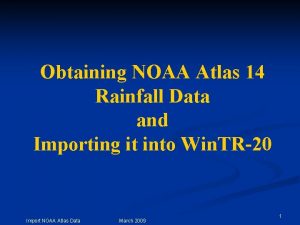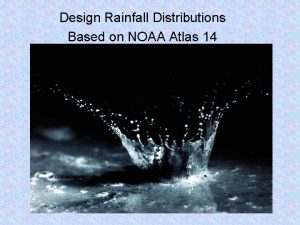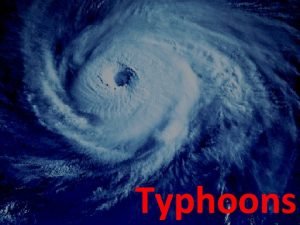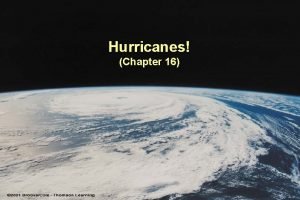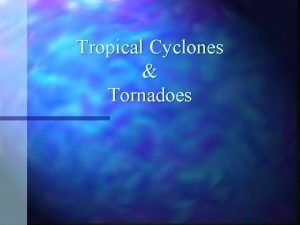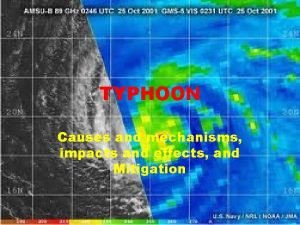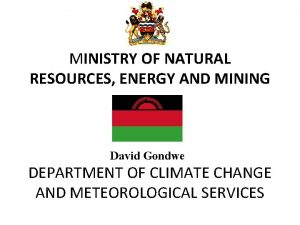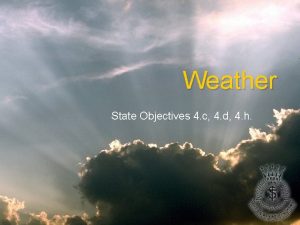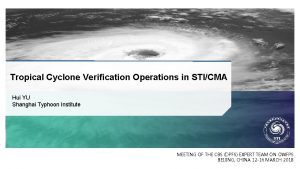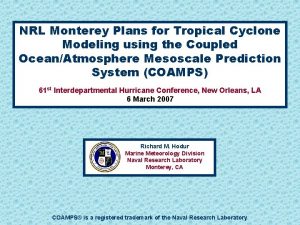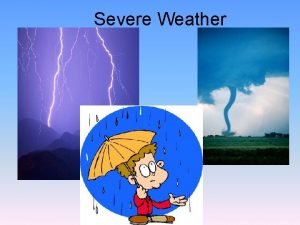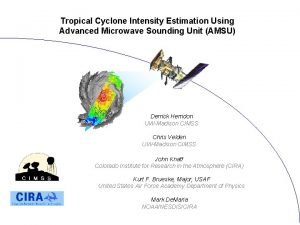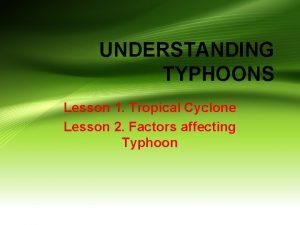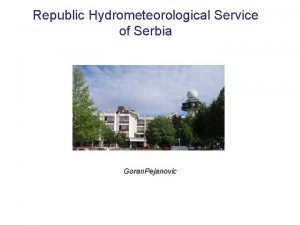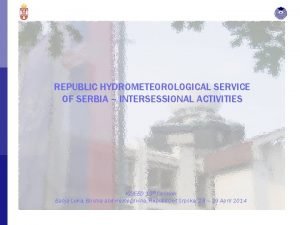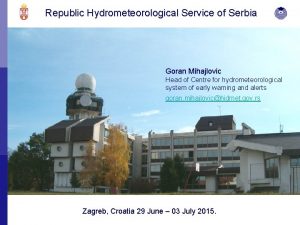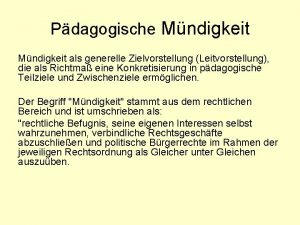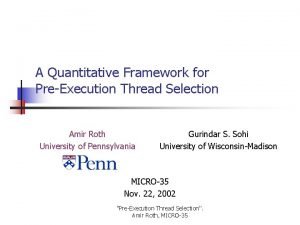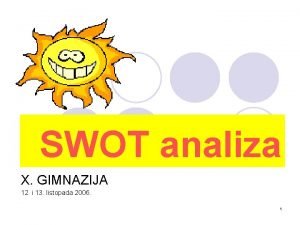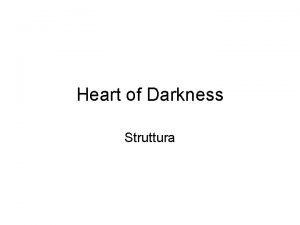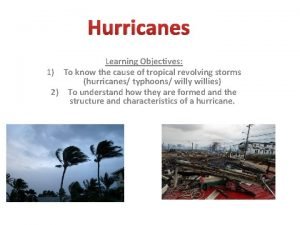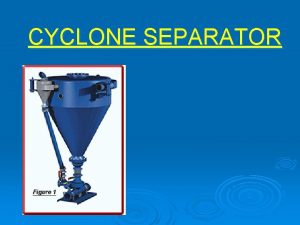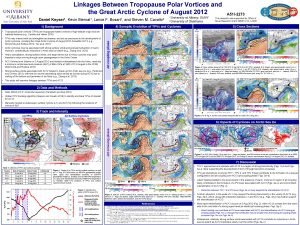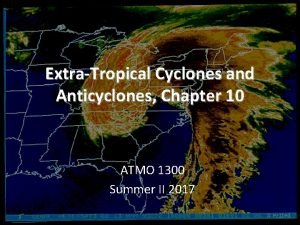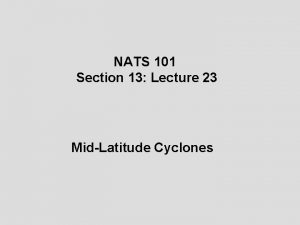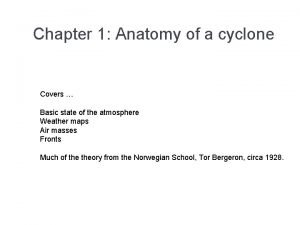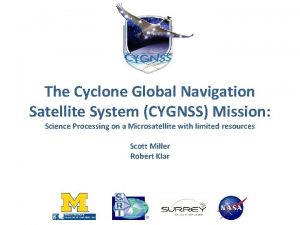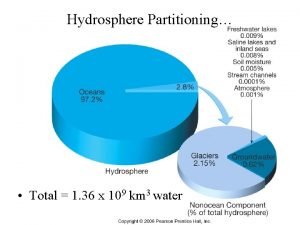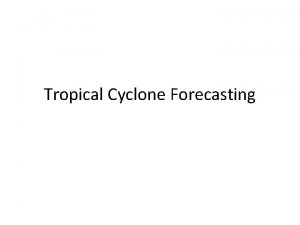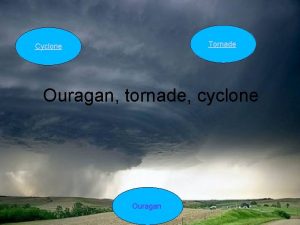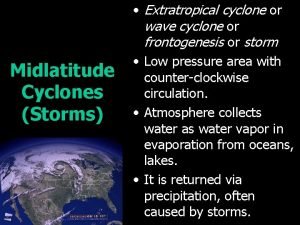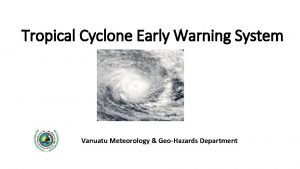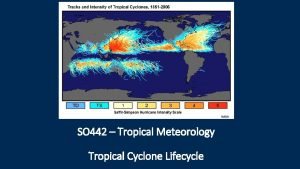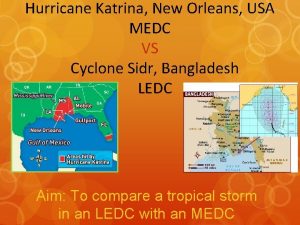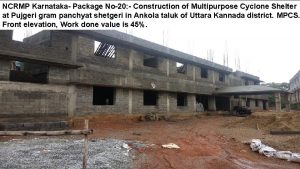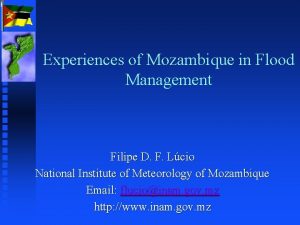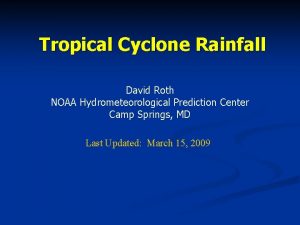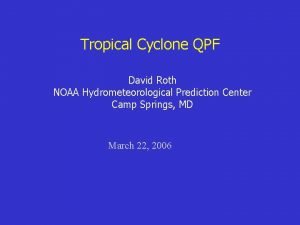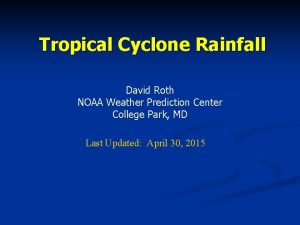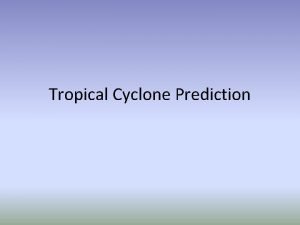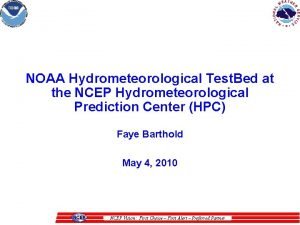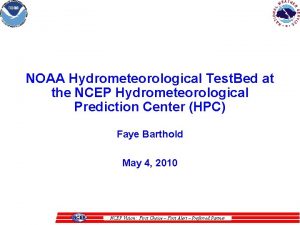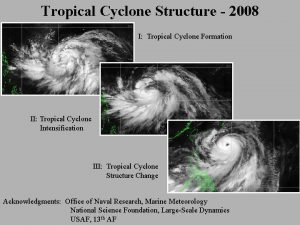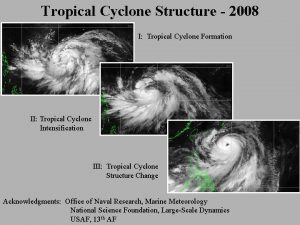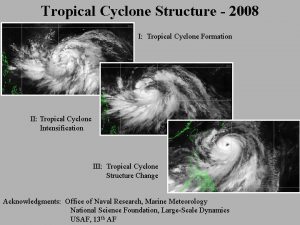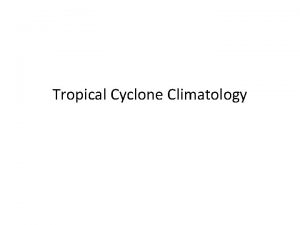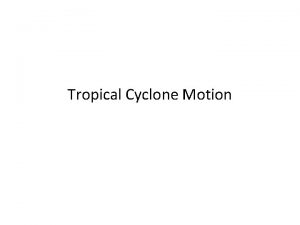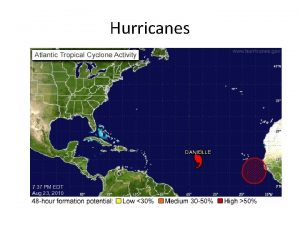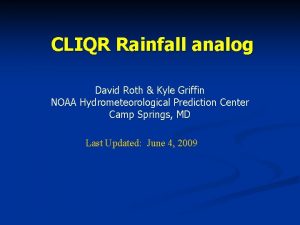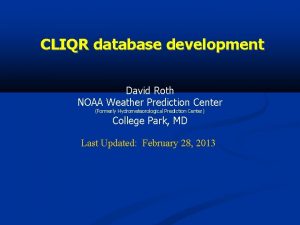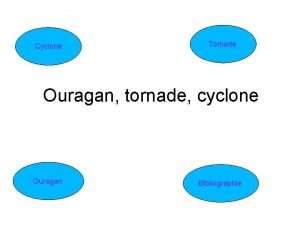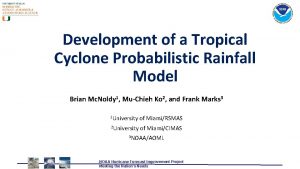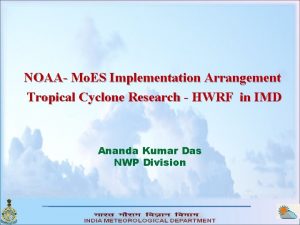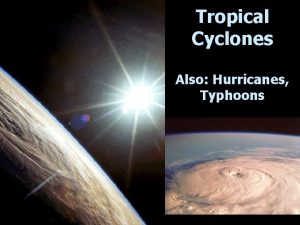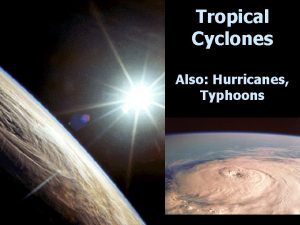Tropical Cyclone Rainfall David Roth NOAA Hydrometeorological Prediction







































































- Slides: 71

Tropical Cyclone Rainfall David Roth NOAA Hydrometeorological Prediction Center Camp Springs, MD Last Updated April 9, 2008

Tropical Cyclone Rainfall Climatology

Timing of Peak activity in Tropical Cyclone Basins After Gray (1975) /Dr. J. Marshall Shepherd (University of Georgia/NASA)

Characteristics of TC precipitation Stratiform and Convective mechanisms • Stratiform rain ~50% of total rain from TC. WSR-88 D DPA daily accumulations Frank Marks (HRD) Hurricane Irene (15 October 1999)


§ TC rainfall peaks when global rainfall is low § Asymmetric-generally more rain in the Northern Hemisphere § Global rainfall is decreasing with increasing latitude while TC rainfall is increasing § TC contributes 10 -17% of global rain 15 -30° poleward from Equator (subtropics) TC Rain Frank Marks (HRD)

Biggest Rain Producers by Country Belize Bermuda Canada Cayman Islands Cuba Dominican Rep. Guadeloupe Haiti Honduras Jamaica Martinique Mexico Nicaragua Panama Puerto Rico St. Maarten United States Venezuela 829. 8 mm 186. 7 mm 302. 0 mm 762 mm 2550 mm 422. 3 mm 507. 8 mm 508 mm 1447. 8 mm 912 mm 2451 mm 450. 1 mm 1634. 0 mm 1597 mm 695 mm 946 mm 866. 6 mm 1219 mm 339 mm 32. 67” 7. 35” 11. 89” 30” 100. 39” 16. 63” 19. 99” 20. 0” 57” 35. 89” 96. 50” 17. 72” 64. 33” 62. 87” 27. 36” 33. 29” 34. 12” 48. 00” 13. 35” Keith (2000) October 1939 Hurricane Harvey (1999) Sanibel Island Hurricane (1944) Flora (1963) Jeanne (2004) Cleo (1964) Marilyn (1995) Flora (1963) Mitch (1998) November 1909 Hurricane Iris (1995) Wilma (2005) Mitch (1998) Eloise (1975) Lenny (1999) Amelia (1978) Bret (1993)

United States Units in cm 2005 US Summer rain Frank Marks (HRD) 2005 US TC rain

Tropical Cyclone vs. Total Seasonal Rainfall in Mexico Art Douglas (Creighton University)

United States

Percent of Maximum storm total rainfall (Hrs) 81 cases – 1991 -2005 Average 0. 92 1. 40 1. 76 2. 04 2. 98 3. 61 5. 01 6. 71 9. 77 11. 48 12. 34 13. 34 Maximum 1. 90 3. 04 4. 56 6. 08 10. 04 13. 47 22. 27 28. 33 32. 52 35. 29 36. 31 40. 68

Percent of Wettest Southwestern TC Rainfall Per Time Frame (hours) 1992 -2006 (8 cases) Average. 56. 94 1. 10 1. 26 1. 70 2. 00 2. 83 3. 15 4. 64 5. 02 5. 05 Max. . 90 1. 60 2. 20 2. 60 3. 10 3. 20 4. 00 6. 60 10. 24 12. 01

Mexico

Tropical Cyclone QPF

Factors impacting rainfall distributions in landfalling TC’s • Storm track (location) • Time of day – core rainfall overnight/ outer band rainfall during day • Storm size (positive) – the bigger the storm, the more it rains at any given spot • Topography – Positive in the upslope areas, but negative past the spine of the mountains • Wind shear (negative) – leads to a quicker dropoff in rainfall for inland TCs • Nearby synoptic-scale features/Extratropical Transition

TC Model Track Error (km) (2002 -2006)

Time of Day – Alberto, July 4 -5, 1994 04/18 z 05/06 z 00 z 12 z 18 z

Storm Size Determined by distance from center to outermost closed isobar <2 degrees Charley 2 -3 degrees “Very small/ midget” “Small” 3 -6 degrees “Average” Frances 6 -8 degrees “Large” Wilma >8 degrees “Very large” Gilbert Joint Typhoon Warning Center Allison

How Mountains Affect the Precipitation Distribution http: //www. prism. oregonstate. edu/index. phtml

Size and Topography Hurricane Frances (2004)

Size and Topography Hurricane Juliette (2001)

Vertical Wind Shear n Heaviest rain tends to fall left and downwind of the shear vector. n If the shear is strong enough, all rainfall may move away from the center (exposed center) Shear vector

Depth of Upper Trough Causing Recurvature Key n n Storms which drop most of the rain right of track are steered predominantly by shear lines or through a break in the subtropical ridge. Rainfall tends to be concentrated near and right of track. Storms which drop most of their rain left of track recurve due to significant upper troughs in the Westerlies. Rainfall streaks out well to the north of the system due to jet streaks moving around the upper trough and frontogenesis at the trough’s leading edge.

Norman W. “Wes” Junker Bertha

Norman W. “Wes” Junker Floyd

Bertha (1996) vs. Floyd (1999)

PRE STATISTICS Separation Distance 1086 ± 482 km Median: 935 km Event Duration 14 ± 7 h Median: 12 h Time Lag 45 ± 29 h Median: 36 h Bosart and Carr (1978) conceptual model of antecedent rainfall

PRE TRACK-RELATIVE POSITIONS 26 Potential for flooding in areas not directly impacted by TC rainfall 12 9

PRE TRACK-RELATIVE POSITIONS 26 Potential for excessive flooding beginning before arrival of TC rainfall 12 9

PRE TRACK-RELATIVE POSITIONS Type of PRE (Number in category) 24 -h rainfall rate statistics (mm) Mean PRE speed (m s− 1) Mea n Std. deviation Maximu m Left of Track (22) 185 70 340 10. 7 Along Track (8) 245 100 410 12. 9 Right of Track (7) 260 80 410 5. 7 GREATEST RAINFALL SLOWEST MOVEMENT

PRE TRACK-RELATIVE POSITIONS Type of PRE (Number in category) 24 -h rainfall rate statistics (mm) Mean PRE speed (m s− 1) Mea n Std. deviation Maximu m Left of Track (22) 185 70 340 10. 7 Along Track (8) 245 100 410 12. 9 Right of Track (7) 260 80 410 5. 7 HIGH RAINFALL PREs MOVE TWICE AS FAST

Along Track PREs 2100 UTC 060830 700 h. Pa Ht (dam) and WSI NOWRAD image 2100 UTC 060830 925 h. Pa Ht (dam), θe (K), and 200 h. Pa wind speed (m s-1) Ernesto (2006) • NW/SE oriented trough well to the northeast • Broad upper-level jet to the north • Closed midlevel low NW and flat ridge east of TC • On western edge of θe ridge

Right Of Track PREs 0900 UTC 050830 700 h. Pa Ht (dam) and WSI NOWRAD image 0900 UTC 050830 925 h. Pa Ht (dam), θe (K), and 200 h. Pa wind speed (m s-1) Katrina (2005) • Large midlevel low NNE and ridge SE of TC • Jet dynamics only partially explain the PREs • PREs a bit downstream of where model predicts • No prominent low-level θe ridge or gradient near PRE

Null Case 0000 UTC 050707 700 h. Pa Ht (dam) and WSI NOWRAD image 0000 UTC 050707 925 h. Pa Ht (dam), θe (K), and 200 h. Pa wind speed (m s-1) Cindy (2005) • WNW flow at midlevels • Scattered rainfall over New England not related to Cindy • Massive low-level ridge poleward of TC • No rainfall near low-level θe ridge

Rainfall forecasts from landfalling TC’s standard forecasting tools • Empirical Methods • In-house Tropical Cyclone Rainfall Climatology http: //www. hpc. ncep. noaa. gov/tropical/rain/tcrainfall. html • GFS/NAM/GFDL/WRF precipitation forecasts • r-CLIPER (Climatology based on 1 st order stations) • TRa. P (persistence to capture structure/Day 1) standard validation tools • bias score • equitable threat score

Rules of Thumb n n Kraft Rule – 1950’s guideline based on a broad grid of first order sites. Will not indicate the maximum in most cases (R=100/forward motion in knots). Environment Canada/Canadian Hurricane Center use a modified version of Kraft which halves this amount since most systems entering the country are sheared. 16 -inch rule – Long term average of tropical cyclone rainfall maxima which strike the United States. Vertical wind shear, small sized tropical cyclones, or movement over cooler water prior to landfall can individually lead to a reduction of about half of this figure. Slow moving and larger than average tropical cyclones lead to higher values than the average.

TPC Method RAIN ACCUMULATION = DIAMETER * RAIN RATE VELOCITY Convective Rainfall Rates Average Climatological Rain Rate = 2 mm / hour Or about 0. 08 in. /hour Core Rain Rate = 5 times this Average or Core Rain Rate = 10 mm /hour Or about 0. 40 in. /hour Reinforced by radial amounts computed within Jiang, Halverson, Simpson AMS Hurricane Conference preprint (2006)

RAINFALL CALCULATION USING UNENHANCED INFRARED IMAGERY FREDERIC Storm Name: __________ Image Date/Time 12 SEPT 79 Date: ________ 19__ Diameter of Storm in Direction of Motion 12 / 0630 UTC ______ 5. 5 605 km _____ deg * 110 km/deg = _____ 12 / 1200 UTC ______ 5. 5 605 km _____ deg * 110 km/deg = ____________ 12 / 1800 UTC _____ deg * 110 km/deg = _____ 4. 0 440 km ______ 12 / 0000 UTC _____ deg * 110 km/deg = _____ 4. 5 495 km Mean Diameter: 540 km D = ____

TROPICAL CYCLONE RAINFALL ESTIMATION HURRICANE FREDERIC, SEPTEMBER 1979 6 -HOUR CONTINUITY, INFRARED

4. 0 Forecast translation speed: Mean rainfall rate: 24 V = _____ deg * 110 km/deg / 18 hrs = _____ km/hr R = 0. 2 cm/hr D*R Rainfall Potential: P = ------V 540 4. 5 km * 0. 2 cm/hr P = ------------------ = ____ cm 24 Core Rainfall: 22. 5 C = 5 * P = ____ cm 450 Rule of Thumb: km/hr (8. 9”) 450 18. 8 T = ----------------- = ____ cm V km/hr 24 km/hr (7. 4”)

Frederic Rainfall

NHC Satellite Tropical Disturbance Rainfall Estimates • 3 event-driven products Eastern Caribbean (40°W to 67°W) TCCA 21 KNHC MIASTDECA Central Caribbean (67°W to 80°W) TCCA 22 KNHC MIASTDCCA Western Caribbean/Mexico (80°W to 120°W) TCCA 23 KNHC MIASTDWCA

Derived Equation used to Determine TC Rainfall Maxima Rainfall maximum=2*(radial velocity)*(specific humidity in subcloud layer)*(pressure difference within lower km of atmosphere)*(1/radius from center)*(1/g) n n n Riehl (1954) Within 30 nm of center – 33. 98” per day Within 60 nm of center – 6. 30” per day Within 120 miles of center – 0. 59” per day Assumes a symmetric/non-sheared hurricane with a gale radius around two degrees of latitude/120 nm. Does not take into account topography or nearby frontal zones.

Picking an analog for a TC event n n n Size is important…look at the current rain shield and compare it to storm totals/storms from the past Is/was there vertical wind shear in current and past events? Look for storms with similar/parallel tracks Is topography/prism data a consideration? Look for nearby fronts/depth of nearby upper troughs for current and possible analogs Not all TC events will have a useful analog

Isbell (1964) vs. Wilma (2005)

Isabel (2003) vs. Fran (1996)

Production of TC QPF • Forecasts made in six-hourly increments from Hour 12 -84 and in one 48 hour chunk for Hours 84 -132 twice a day by 3 forecasters (Day 1, Day 2/3, and Medium Range temps/pops) • Start With Model Closest to TPC Forecast (usually GFS) • Locate relevant synoptic scale boundaries/coastal front • Use conceptual models/current structure to modify/shift QPF (TRa. P and recent satellite/radar imagery for current structure) • Look at storm-relative shear/H 2 winds to further shift/limit QPF • Use climatology (PRISM, r-CLIPER, TC Rainfall Climatology) to: Temper down forecast bias/act as a reality check Depict areas of terrain that could be significantly impacted Help Create TC rainfall statements for the Public Advisories • Forecasts issued at by 06/18 z (Days 1 -3) and 12 z/0 z (Days 4 -5 and 5 -day accumulation graphic)

Dependence on TPC track - Rita Threat/Bias for 5 Day QPF September 21/12 z Forecast 0. 25. 453 1. 52 H G. 498 1. 39 0. 50. 350 1. 46 H G. 414 1. 35 1. 00. 197. 961 H G. 258 1. 24 2. 00. 030. 725 H G. 168. 858 3. 00. 013 1. 28 H G. 093 1. 06 4. 009 2. 61 H G. 069 1. 86 5. 000 3. 49 H G. 021 3. 01 6. 000 4. 23 H G. 018 4. 69 September 22/12 z Forecast 0. 25. 536 1. 33 H G. 541 1. 08 0. 50. 468 1. 18 H G. 534. 978 1. 00. 367 1. 07 H G. 366. 781 2. 00. 164. 777 H G. 234. 792 3. 00. 163 1. 35 H G. 224. 916 4. 00. 128 2. 50 H G. 199 1. 63 5. 00. 090 3. 74 H G. 174 2. 18 6. 00. 090 5. 71 H G. 161 2. 98

Specialized Tropical Cyclone QPF Guidance

R-CLIPER §R-CLIPER (Rainfall Climatology Parametric Model) –Statistical model developed from TMI data and rain gauges –Simple model creates a rainfall swath dependent on storm track, intensity, and size –Operational at 0. 25 o X 0. 25 o hourly resolution –Asymmetries are not taken into account

R-CLIPER Improvements Includes shear and topographic effects in 2007 R-CLIPER + Shear + Topog

TRa. P Can be found at NOAA/NESDIS Satellite Analysis Branch (SAB) http: //www. ssd. noaa. gov/PS/TROP/trap. html Uses microwave rain rate images from SSM/I, TRMM, and AMSU and extrapolates along TC forecast track. METOP and SSMI/S, part of AMSU, expected by the end of the year Only available when a microwave pass “catches” the storm mostly within the swath Depends on official forecast of TC track from NHC, CPHC, etc.

TRa. P: http: //www. ssd. noaa. gov/PS/TROP/trap. html

Katrina Rainfall

Flow of rainfall-related data to and from the Hydrometeorological Prediction Center (HPC)

Flow of rainfall data to HPC

Flow of tropical cyclone rainfall forecasts within the National Weather Service (NWS) Statement Graphics Four times a day A day

Model Forecast Biases/ Verification relating to Tropical Cyclone QPF

QPF Equitable Threat Score ETS = Fcst Where H = “Hit” area H - chance F + O – H -chance F = Forecast rain area O = Observed rain area No overlap: Hit area = 0 ETS ~ 0 Obs Hit Area Hit area = ½ Forecast area ETS ~ 0. 33 Hit area = Forecast area ETS = 1. 0

Pattern comparisons for U. S. landfalling storms From Rogers, Black, Marchok, 2005 IHC Equitable Threat Score

QPF Skill – Core Rainfall (1998 -2004) From Rogers, Black, Marchok, 2005 IHC 0 -100 km

Summary comparison for all models From Rogers, Black, Marchok, 2005 IHC Pattern • GFS performs best • all models show skill relative to R -CLIPER • GFDL worst among numerical models Volume • All models essentially equivalent • GFS slightly better • all show skill over R-CLIPER

Summary comparison for all models (cont. ) Extremes • GFS best • GFDL produces too much of heaviest rain • both show skill over R-CLIPER • Eta shows no skill over R-CLIPER Sensitivity to track error • GFS least sensitive to track error • GFDL, Eta more sensitive to track error than R-CLIPER

HPC tropical cyclone QPF verification since 2004







Summary n n n Tropical cyclones lead to 10 -20% of annual rainfall in South and Eastern U. S. While tropical cyclones lead to a smaller percent of annual rainfall for the Desert Southwest regionally on an annual basis, individual events can lead to a significant portion of the annual rainfall on a local basis. Tropical cyclone QPF pattern depends on storm size, forecast track, vertical wind shear, topography, depth of upper trough causing recurvature, and SST field the cyclone moves over prior to landfall While climatology is important to keep in mind, TC QPF is heavily based on the guidance which has the best verification and is closest to expected TC track (usually GFS). ECMWF verification will be looked at after 2007 season, but recent verification shows promise across the United States.
 Nn roth
Nn roth Noaa atlas 14
Noaa atlas 14 Nrcs rainfall distribution
Nrcs rainfall distribution A recipe of a tropical cyclone
A recipe of a tropical cyclone Hurricane cross section
Hurricane cross section Tropical cyclone tornadoes
Tropical cyclone tornadoes Immature stage of tropical cyclone
Immature stage of tropical cyclone Mining
Mining Parts of tropical cyclone
Parts of tropical cyclone Sticma
Sticma Nrl monterey tropical cyclone
Nrl monterey tropical cyclone Map of tornado alley
Map of tornado alley Tropical cyclone
Tropical cyclone Understanding typhoons
Understanding typhoons 119-200 kph
119-200 kph Rainfall in temperate forest
Rainfall in temperate forest Czech hydrometeorological institute
Czech hydrometeorological institute Republic hydrometeorological service of serbia
Republic hydrometeorological service of serbia Hidmetgov
Hidmetgov Hydrometeorological hazard map
Hydrometeorological hazard map Republic hydrometeorological institute of serbia
Republic hydrometeorological institute of serbia Moodle rshu
Moodle rshu Republic hydrometeorological institute of serbia
Republic hydrometeorological institute of serbia Primerica ira roth
Primerica ira roth Cis 519
Cis 519 Marcie roth
Marcie roth Neuron yale tutorial
Neuron yale tutorial Eli the fanatic summary
Eli the fanatic summary Pädagogische leitvorstellungen beispiele
Pädagogische leitvorstellungen beispiele Roth ira hamilton
Roth ira hamilton Stefan roth rwth
Stefan roth rwth Gerhard roth willensfreiheit ist eine illusion plato schema
Gerhard roth willensfreiheit ist eine illusion plato schema Backdoor roth ira conversion white coat investor
Backdoor roth ira conversion white coat investor Trees upenn
Trees upenn Xkcd
Xkcd Nm interlock indigent fund
Nm interlock indigent fund Polyzentrischer ansatz
Polyzentrischer ansatz Amir roth
Amir roth Marija roth psiholog
Marija roth psiholog John reece roth
John reece roth Cis419
Cis419 Meralgia parestesica cura
Meralgia parestesica cura Gehirngewicht schimpanse
Gehirngewicht schimpanse Roth robertson
Roth robertson The metamorphosis movie 1987
The metamorphosis movie 1987 Artikulationsschema grell
Artikulationsschema grell Zvi roth
Zvi roth Tim roth heart of darkness
Tim roth heart of darkness Objectives of cyclone
Objectives of cyclone Cyclone chemical engineering
Cyclone chemical engineering Arctic cyclone
Arctic cyclone Cyclone 4014c
Cyclone 4014c Norwegian cyclone model
Norwegian cyclone model Mechanical operation
Mechanical operation Cyclone lucy
Cyclone lucy Stage of cyclone
Stage of cyclone Occluded front
Occluded front Cyclone programming language
Cyclone programming language Cyclone global navigation satellite system
Cyclone global navigation satellite system Mid latitude cyclone
Mid latitude cyclone Cross section of hagibis
Cross section of hagibis Ouragan tornade
Ouragan tornade Occluded front cross section
Occluded front cross section Mid latitude cyclone characteristics
Mid latitude cyclone characteristics Vanuatu meteorology
Vanuatu meteorology Life cycle of cyclone
Life cycle of cyclone Skc aluminum cyclone
Skc aluminum cyclone Objectives of size separation ppt
Objectives of size separation ppt New orleans cyclone
New orleans cyclone Cyclone shelter
Cyclone shelter Filipe d
Filipe d Cyclone cgx
Cyclone cgx

